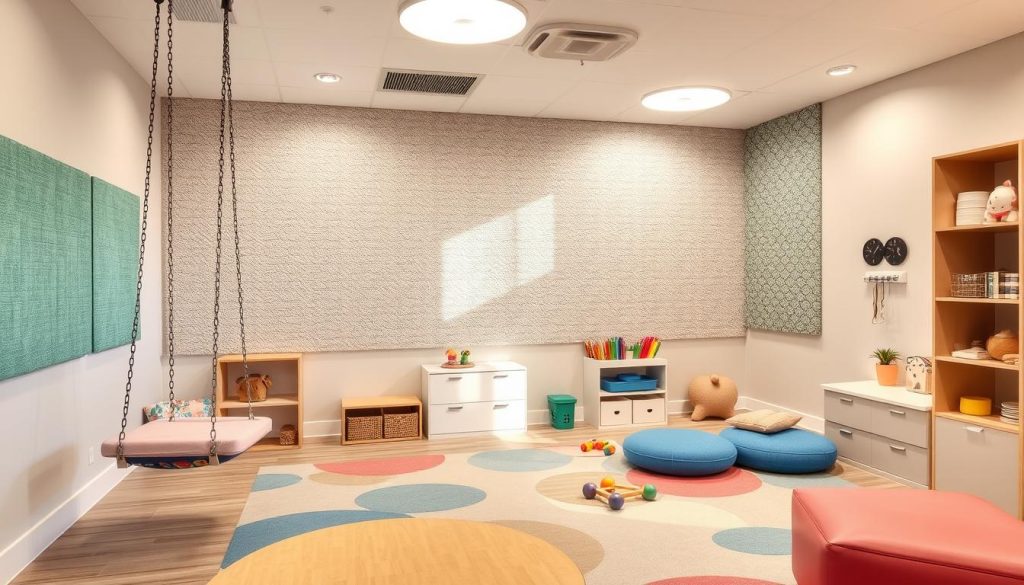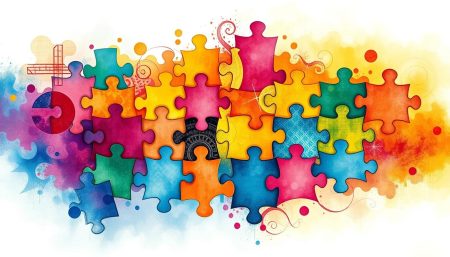The world of autism spectrum disorder (ASD) comes with a special challenge: sensory processing disorder (SPD).
SPD affects how our nervous system handles sensory information. It turns these messages into actions and behaviors. For those with SPD, this process can be too much or too little, making everyday tasks hard.
People with ASD face sensory issues every day. It makes social interactions and dealing with loud places tough. Understanding sensory processing is key to better lives for those with autism and sensory processing challenges.
Groups like the American Occupational Therapy Association and Autism Speaks highlight the link between sensory processing and autism. Recognizing this connection is the first step towards better support and help. It’s vital for those trying to handle the constant sensory overload in their world.
Getting to know both ASD and SPD helps us communicate better. It leads to more effective treatments and understanding of the autism community’s experiences.
What is Sensory Processing Disorder?
Sensory Processing Disorder (SPD) is a complex condition that affects how the brain handles sensory information. People with SPD might find everyday sensory information too much or not enough. Learning how SPD works is key to understanding it.
The Basics of Sensory Integration
Sensory integration is how the brain makes sense of sensory information like touch, sound, and movement. It’s essential for doing everyday tasks well. But, if it’s not working right, it can cause big problems.
Identifying Signs and Symptoms of SPD
It’s important to know the signs and symptoms of SPD to help early. Common signs include being very sensitive to sensory inputs, having trouble talking or playing with others, and reacting too much or too little to physical sensations.
Here’s a table with common symptoms of SPD to help spot sensory processing issues:
| Symptom Category | Behavioral Indicators | Impact on Daily Activities |
|---|---|---|
| Hyper-responsiveness | Aversion to touch, sound, or light; startling easily; emotional outbursts. | Difficulty in crowded environments; challenges in social settings. |
| Hypo-responsiveness | Seeming oblivious to surroundings; lack of response to pain or extreme temperatures. | Increased risk of personal injury; isolation due to withdrawal in activities requiring response to sensory input. |
| Sensory Seeking | Constant need for movement; fidgeting; touching people or textures. | Disruption in classrooms or work; difficulty in maintaining personal space. |
Knowing about these challenges is a big step towards managing SPD. Early diagnosis and the right help can really improve life for those with SPD.
Exploring the Connection Between Sensory Processing Disorder and Autism Spectrum Disorder
The link between autism spectrum disorder (ASD) and sensory processing disorder (SPD) is a hot topic in research. Many people have both conditions, making it key to study their connection. This helps us find better ways to help them.
People with autism often face sensory challenges. This shows that sensory issues might be a big part of autism. Or, there’s a strong link between the two conditions in the brain.
- High prevalence of sensory sensitivities among those diagnosed with ASD.
- Common challenges in sensory modulation, integration, and discrimination.
- Behavioral overlaps, such as avoidance or seeking of sensory input.
Studies show that people with autism have unusual sensory responses. They might feel things more intensely or differently than others. This is similar to what we see in SPD.
| Characteristic | Autism Spectrum Disorder (ASD) | Sensory Processing Disorder (SPD) |
|---|---|---|
| Sensory Sensitivity | High | High |
| Behavioral Response | Varies (Seeking/Avoidance) | Varies (Seeking/Avoidance) |
| Impact on Daily Activities | Significant | Significant |
| Need for Tailored Interventions | Essential | Essential |
It’s clear that tackling sensory problems is key to managing autism. Research from neurology and behavior studies supports this. We need treatments that address both ASD and SPD.
The Impact of Sensory Processing Challenges on Autistic Individuals
People on the autism spectrum often face sensory sensitivities that change their daily lives. It’s key to understand these challenges to help them better. This part talks about how these issues show up in behavior and how to deal with them.
Behavioral Manifestations of Sensory Overload
Sensory overload can lead to different behaviors in those with autism. They might get very frustrated, avoid certain places, or even cover their ears or eyes. It’s vital to see these signs as they show how uncomfortable someone is and what they need to feel better.
Coping Mechanisms for Sensory Sensitivities
To handle sensory sensitivities, people with autism and their caregivers use different strategies. They might wear special clothes, follow set routines, or make spaces less overwhelming. They also try therapies like sensory integration to handle sensory information better.
Using these strategies can lessen sensory overload and improve well-being. It lets people with autism join in more with daily life and social activities. By understanding and meeting their sensory needs, we can make places more welcoming and supportive for them.
Understanding Sensory Processing Disorder in the Autism Community
Sensory issues are a big part of autism spectrum disorder. They affect daily life and how people interact with others. This section explores the prevalence in autism and shares personal anecdotes. These stories help us understand what it’s like to live with these challenges.
Prevalence of Sensory Issues in Autistic Populations
Studies show that many people with autism have sensory processing disorders. This means they might be very sensitive to sounds or touch. This sensitivity can change how they behave and learn.
It’s important to know how common this is. This knowledge helps us create better support and treatments.
Personal Anecdotes and Case Studies
Stories from the autism community give us a deeper look into their lives. One story talks about a young adult who finds peace through special therapies. It shows how these therapies can help.
Another story is about a child who benefits from sensory-friendly classrooms. It shows how these environments can improve learning.
These personal anecdotes show us the wide range of sensory issues in autism. They encourage us to be more understanding and supportive. By listening to these stories, we can offer better care and support.
Diagnosing Sensory Processing Disorder in Conjunction with Autism
Diagnosing Sensory Processing Disorder (SPD) with autism is a big challenge. It’s hard to tell the difference between SPD and autism’s sensory traits. Getting it right is key to helping the person.
Differential Diagnosis: SPD Versus Autism-Related Sensory Preferences
It’s important to know the difference between SPD and autism’s sensory traits. Both have unusual sensory behaviors, but they mean different things. Autism’s sensory traits mainly affect how people communicate and interact. SPD, on the other hand, makes it hard to handle all kinds of sensory information, affecting daily life.
Collaborating with Health Professionals for Accurate Diagnosis
Diagnosing SPD needs a team effort. This team includes psychologists, occupational therapists, and sometimes neurologists or psychiatrists. They use observations, patient history, and special tests to figure it out.
| Assessment Criterion | SPD | Autism-Related Sensory Preferences |
|---|---|---|
| Impact on Daily Functioning | Extensive across various settings | Specific to social and communicative contexts |
| Behavioral Response to Sensory Input | Consistent patterns of over- or under-reaction | Variable, often linked to context or environment |
| Response to Sensory Integration Therapy | Typically positive, noticeable improvement | Mixed, depends heavily on individual characteristics |
| Associated Developmental Delays | Possible, but not specific to cognitive domains | Often present, specially in language and social skills |
Understanding the differences helps doctors give better care. This way, they can improve the person’s life a lot.
Assessment Tools for Detecting Sensory Processing Challenges
In the world of autism spectrum disorders, finding the right assessment tools is key. These tools help detect sensory processing challenges. This section explores the different tests and methods used by professionals.
Standardized tests are reliable for spotting sensory issues. They make sure observations are consistent and can be compared. But, every autistic person is different, which can make standardization tricky.
Observational methods offer a deeper look at sensory challenges. They involve watching how people react in real-life settings. This method catches details that tests might miss.
To understand these methods better, here’s a comparison of popular tools:
| Assessment Tool | Type | Advantages | Limitations |
|---|---|---|---|
| Sensory Profile | Standardized Test | Provides detailed results and covers many sensory issues. | May miss the fine details; needs careful analysis. |
| Clinical Observation | Observational Method | Gives immediate insights; fits the individual’s life. | Can be subjective, leading to varied results. |
| Sensory Integration and Praxis Tests (SIPT) | Standardized Test | Uses scientific tasks to measure sensory integration. | Needs a lot of training to use and understand. |
| Behavioral Mapping | Observational Method | Allows for observation in different places; very flexible. | Requires a lot of time and might need to be done many times. |
Choosing the right assessment tools for detecting sensory processing challenges in autism is vital. Using both tests and observations helps clinicians understand an individual’s needs fully.
Examining the Effects of Sensory Processing Disorder on Daily Life
Sensory Processing Disorder (SPD) deeply affects daily life. It impacts education and social connections. This section looks at how these challenges arise and the need for support and understanding.
Education and Learning Challenges
SPD makes learning hard for those affected. It disrupts the ability to process information in school. Students struggle with focus, following instructions, and handling loud noises or bright lights.
Teachers are key in helping students with SPD. They adapt learning methods to meet these needs. This can include quiet spaces, sensory aids, and strategies for sensory sensitivities.
Interpersonal Relationships and Social Interaction
SPD also affects social relationships. It can make social situations overwhelming. This leads to social anxiety, withdrawal, and misunderstandings in interactions.
Support from family and friends is vital. Social skills training and therapy help improve social interactions. This way, individuals with SPD can build meaningful relationships.
SPD requires understanding and accommodations from society. These changes can improve the lives of those affected. They help create a more inclusive community.
Intervention Strategies for Sensory Processing Difficulties
For those with sensory processing challenges, finding the right intervention strategies can change their lives. Sensory integration therapy and adaptive techniques help improve daily life and overall happiness.
Sensory Integration Therapy and Its Benefits
Sensory integration therapy is a key strategy. It helps those with sensory issues, like those with autism. It helps the brain process sensory information better, leading to better motor and behavior skills.
It reduces sensitivity to sensory inputs, boosts learning, and improves social skills. Therapists use special tools and exercises to help the senses adapt. This way, patients can better handle their surroundings.
Adaptive Techniques for Home and School Environments
Adaptive techniques are vital in homes and schools for those with sensory sensitivities. They include structured sensory play and changes to the environment. These aim to reduce sensory overload and create better learning and living spaces.
| Technique | Application | Benefit |
|---|---|---|
| Visual Schedules | School and Home | Increases predictability and reduces anxiety |
| Modified Lighting | Classrooms, Bedrooms | Minimizes visual stress and improves concentration |
| Textured Materials | Sensory Play Areas | Enhances tactile response and motor skills |
These strategies, including special therapies and environmental changes, help with sensory integration. They also improve how people cope with their challenges. By using these in daily life, caregivers and teachers can make environments more inclusive and friendly for everyone.
The Science of Sensory Processing Disorder: Neuroscience Insights
Exploring the science of SPD gives us a peek into how our brains handle sensory info. New findings in neuroscience insights are uncovering the brain’s complex ways in Sensory Processing Disorder (SPD). This growing field helps us understand how the brain reacts differently to sensory inputs in people with SPD.
At the heart of understanding science of SPD is seeing how our brains process sensory signals. Studies show that those with SPD might have brain issues in these processes. This can change how they act and feel.
The table below shows important research findings that explain these brain differences:
| Study Focus | Key Findings | Implications |
|---|---|---|
| Neural Connectivity | Altered neural pathways in sensory processing regions | Potential targets for therapeutic intervention |
| Brain Plasticity | Less flexibility in response to sensory stimuli | Insights into adaptive therapies |
| Response to Therapy | Changes in brain activity post-therapy | Effectiveness of specific interventions |
These neuroscience insights give us a clear look at SPD’s biological roots. They point to new research and treatment paths. Knowing how our brains react to sensory info helps us better understand SPD. It also leads to more effective ways to help those with SPD.
Emotional and Psychological Aspects of Sensory Processing Disorders
Understanding the emotional and psychological sides of sensory processing disorders (SPD) is key. It helps meet the full needs of kids with SPD and autism spectrum disorder (ASD). We need to look closely at how stress and anxiety affect these young ones. This section will explore ways to help them feel emotionally stable and strong.
Stress, Anxiety, and SPD
The connection between stress and SPD starts with too much sensory input for kids. This can cause a lot of anxiety, making everyday life and learning hard. The stress can make social and school challenges even tougher, affecting their growth and feelings.

Supporting Emotional Well-Being in Children with SPD and ASD
Helping kids with SPD and ASD emotionally means using many different methods. Some important steps include:
- Creating safe, sensory-friendly places that help them feel calm and secure.
- Using therapies like cognitive-behavioral therapy (CBT) to help manage anxiety. It changes negative thoughts about too much sensory input.
- Encouraging regular exercise, which can lower stress and boost mental strength.
By using these strategies, kids can better handle their sensory sensitivities. This helps them live emotionally and mentally fulfilling lives. This approach not only helps them now but also prepares them for the future. It shows how important it is to care for their feelings as well as their sensory needs.
Educational Approaches for Children with Sensory Processing Issues
It’s important to understand and meet the educational needs of kids with sensory processing issues. By using the right educational approaches and working together, these children can do well in school and with friends. Schools and therapy programs are now making changes to help these kids.
Inclusive Education Strategies
Inclusive education strategies help kids with sensory processing issues fit in with their classmates. This way, everyone learns more and has a better time. It means teaching in a way that works for each student, using special materials, and making the classroom just right.
Collaboration Between Educators, Parents, and Therapists
Working together is key to helping kids with sensory processing issues. Teachers, parents, and therapists need to talk and share ideas to help these kids learn better. This teamwork makes sure everyone is on the same page and helps the kids succeed.
- Regular meetings to talk about how the student is doing.
- Workshops for parents and teachers to learn more about sensory processing.
- Using therapy goals in school plans to support the whole child.
| Strategy | Benefits | Implementation Example |
|---|---|---|
| Customizable Learning Environments | Reduces sensory overload, enhances focus | Adjustable lighting and sound-proofed learning stations |
| Therapist-Educator Co-Planning | Ensures therapeutic insights inform teaching tactics | Monthly collaboration sessions to align on strategies |
| Sensory Tools in Classrooms | Increases student engagement, reduces disruptions | Provision of sensory toys and tools that students can use during lessons |
Parental Guidance on Navigating Autism and Sensory Processing Challenges
Parenting a child with autism and sensory processing disorders is complex. It requires a lot of guidance and flexibility. By setting up daily routines and building a strong support network, parents can greatly improve their child’s life. This section will share practical tips to help parents in these efforts.
Practical Tips for Daily Routines
Creating structured daily routines is key for kids with sensory processing issues. It helps reduce anxiety and sensory overload. Parents should:
- Keep meal, school, homework, and bedtime times the same for a sense of security.
- Use visual schedules or charts to help kids know what’s coming next, lowering anxiety.
- Include sensory breaks like quiet time, physical activities, or sensory bins to meet their needs.
- Slowly add new activities to the routine to avoid overwhelming them.
Building a Support Network for Families
Having a strong support network is essential for families dealing with autism and sensory processing. This network offers emotional support, practical help, and information sharing. Parents can:
- Join local and online support groups to share experiences and find resources.
- Work with therapists, counselors, and educators who understand sensory processing.
- Ask family and friends for respite care to give parents a break.
- Communicate with other parents to learn from their experiences and strategies.
| Strategy | Benefits | Examples |
|---|---|---|
| Visual Schedules | Increases predictability, reduces anxiety | Charts, apps |
| Sensory Breaks | Manages sensory overload, improves focus | Quiet time, fidget tools |
| Support Groups | Provides emotional and informational support | Online platforms, community centers |
| Professional Help | Personalized care and strategies | Therapists, special educators |
Technology and Innovations in Sensory Processing Therapy
The use of technology in therapy is changing how we treat sensory processing disorder (SPD). It’s making treatments more personal and effective. New tools and apps are coming out, changing how therapy is done for both therapists and patients.
Virtual reality, wearable devices, and interactive software are being used in therapy. They make sessions more fun and accessible. These tools help improve how people with SPD handle different sensory inputs.
- Virtual Reality (VR): VR creates safe, real-world environments for people with SPD to get used to different sensory inputs.
- Wearable Technology: Devices like these adjust the sensory input for users, helping them deal with too much environmental stimulation.
- Apps and Software: Special apps help with consistent sensory training and tracking progress, letting therapists and patients see how treatments are working.
These technological advancements help create specific therapy plans. Here’s how some of these technologies are used in SPD therapy:
| Technology | Use in Therapy | Key Benefit |
|---|---|---|
| Virtual Reality (VR) | Simulation of environments for sensory adaptation | Controlled exposure |
| Wearable Devices | Sensory input modulation | Personalized sensory management |
| Therapeutic Apps | Progress tracking and sensory exercises | Accessibility and consistency |
The future of innovations in SPD therapy looks bright. It promises more tailored, effective, and fun therapy options. As technology in therapy keeps improving, the outlook for those with SPD is getting better.
Advocacy and Awareness: Building a Supportive Community for Autism and Sensory Processing Disorder
Raising awareness and advocacy for autism and sensory processing disorder (SPD) is key. It helps create a more inclusive society. Good advocacy lets those affected be heard and helps others understand and accept them.
Fostering Acceptance and Understanding
Community efforts and education are vital for acceptance. They help clear up the challenges of SPD and autism. By focusing on what people can do, not what they can’t, we build a stronger community.
It’s about embracing diversity and teaching others. We need to spread empathy and unity in all parts of society.
The Role of Organizations and Policy in Supporting Individuals with SPD and ASD
Organizations focused on SPD and autism lead the way to change. They work with lawmakers to improve education, healthcare, and work places.
Good policy is also key. It brings in funds, guides laws, and supports research. These efforts greatly improve life for those with SPD and autism and strengthen community support.
The Role of Occupational Therapy in Sensory Processing and Autism
Occupational therapy is key for those with sensory processing disorders and autism. It helps improve daily living skills and quality of life. Therapists use specific strategies to tackle sensory issues and boost social, emotional, and physical skills.

Customized Occupational Therapy Interventions
Every person gets unique help in occupational therapy. This might include sensory integration, motor skill development, and learning daily tasks. The goal is to help them be more independent and take part in daily activities and social events.
- Development of personalized sensory diets
- Implementation of assistive technologies
- Training for caregivers and educators
Success Stories from Occupational Therapy
Occupational therapy has changed lives for many. People say it helps them handle sensory issues better. This leads to better school, work, and social life.
- Increased engagement in social activities
- Improved self-regulation skills
- Enhanced learning outcomes
These stories motivate families and individuals facing similar issues. They show how vital occupational therapy is for treating autism and sensory processing disorders.
Future Directions in Research and Treatment for Sensory Processing Disorder and Autism Spectrum Disorder
The world of sensory processing disorder (SPD) and autism spectrum disorder (ASD) is changing fast. New research is helping us understand and treat these conditions better. Experts are working together to learn how sensory processing and autism are connected.
They hope to create treatments that fit each person’s needs. This could lead to big improvements in how we help people with SPD and ASD.
Top researchers are studying the genetic and brain factors behind SPD and ASD. They want to find out why some people have trouble with their senses. This could lead to new medicines and therapies that really help.
Technology is also playing a big role. It’s helping create special environments that help people with SPD and ASD. Things like virtual reality and special devices could make a big difference in their lives.
There’s also a focus on helping people feel more connected and emotionally strong. Programs and schools are working to include everyone. This approach is all about supporting the whole person.
Looking ahead, we can expect even better treatments. This will come from working together in science, technology, and care. Together, we can make a real difference in the lives of those with SPD and ASD.
FAQ
Q: What are sensory processing disorder (SPD) and autism spectrum disorder (ASD)?
A: Sensory Processing Disorder is when the brain has trouble with sensory information. Autism Spectrum Disorder affects how people communicate and behave. SPD often happens with autism, causing sensory problems.
Q: How does sensory integration dysfunction relate to SPD?
A: Sensory integration dysfunction is a big part of SPD. It means the brain can’t handle sensory information right. This can make it hard to move, balance, and react to things around us.
Q: Can you list some common signs and symptoms of SPD?
A: Signs of SPD include extreme reactions to sounds and sights. People might get distracted easily or have trouble with coordination. They might also find it hard to play or interact with others.
Q: What is the neurological connection between SPD and ASD?
A: Both SPD and ASD deal with how the brain processes information. Studies show that people with autism often have trouble with sensory processing. The brain areas involved in both conditions are similar.
Q: How do sensory processing challenges impact individuals with autism?
A: Sensory challenges can cause too much stimulation, affecting behavior and emotions. It can make everyday tasks hard. People might struggle in social situations and find certain environments overwhelming.
Q: How prevalent are sensory issues among individuals with ASD?
A: Many people with autism face sensory challenges. Research shows that most on the autism spectrum deal with some form of sensory processing issues.
Q: What distinguishes sensory preferences in autism from SPD?
A: Sensory preferences in autism are part of the autism diagnosis. They can include fixations or avoidance behaviors. SPD symptoms, while sometimes similar, are a separate condition with different sensory integration issues.
Q: What assessment tools are used to detect sensory processing challenges?
A: Experts use various tools to find sensory processing challenges. These include the Sensory Profile and detailed observations of how someone reacts to sensory stimuli.
Q: What effects can SPD have on education and learning?
A: SPD can make it hard to focus in school, follow instructions, and join in activities. Sensory sensitivities can also lead to social problems and disrupt the classroom.
Q: What are some intervention strategies for sensory processing difficulties?
A: Strategies include sensory integration therapy and creating sensory-friendly spaces. Tailored educational plans are also used. These help improve sensory regulation and daily life for those with SPD.
Q: How does understanding the neuroscience behind SPD help?
A: Knowing the neuroscience of SPD helps develop targeted therapies. It also leads to better diagnostics and treatments.
Q: What strategies can support the emotional well-being of children with SPD and ASD?
A: Strategies include structured routines, teaching coping skills, and a supportive environment. This helps children with SPD and ASD emotionally.
Q: How can inclusive education strategies benefit children with sensory processing issues?
A: Inclusive education supports diverse learning needs. It allows children with sensory issues to learn with their peers while getting the help they need.
Q: What practical tips can help parents manage daily routines for children with autism and SPD?
A: Parents can use consistent routines, visual schedules, and sensory breaks. It’s also key to work with education and healthcare professionals for support.
Q: How is technology influencing sensory processing therapy?
A: Technology offers new tools for sensory exercises. It personalizes therapy and makes it more engaging for addressing sensory challenges.
Q: Why is advocacy important for individuals with autism and sensory processing disorder?
A: Advocacy raises awareness and promotes acceptance. It leads to policy changes and resources for support and research.
Q: What role does occupational therapy play in addressing SPD and autism?
A: Occupational therapy is key for developing skills for everyday activities. Therapists provide customized interventions for sensory integration and independence.
Q: What future research and treatment advances are anticipated for SPD and ASD?
A: Researchers are studying the biology of SPD and ASD for better treatments. Advances in genomics and personalized medicine promise more effective interventions in the future.


















